2012 U.S. Championships News
For more information, please contact:
Kiley Herndon
Chess Club and Scholastic Center of Saint Louis
(314) 283-7068
kherndon@saintlouischessclub.org
For Immediate Release
Champions Showdown Fit for Kings
Four of the world’s top players set to compete in Saint Louis
SAINT LOUIS (October 31, 2016) – This November, in true holiday spirit, the Chess Club and Scholastic Center of Saint Louis will host a showdown between four of the top rated players in the world. Over five days in the ultimate champions matchup, No. 3 rated Fabiano Caruana, No. 7 rated Hikaru Nakamura, and two former world champions, No. 8 Viswanathan Anand of India and No. 13 Veselin Topalov of Bulgaria, will compete in three different styles of chess.
“This not only brings four of the world’s top players back to Saint Louis,” said Tony Rich, Executive Director of the Chess Club and Scholastic Center of Saint Louis, “but also provides an opportunity for fans to enjoy different styles of play across the increasingly fast time controls.”
The tournament format is as intense as the players, featuring classical, rapid, and blitz games. Players will be competing for $150,000 in prize money and the chance to gain yet another title.
Fabiano Caruana is the No. 3 ranked player in the world and became a grandmaster at 14 years old. In October 2014 he achieved a rating of 2844, becoming the third highest-rated player in history. Caruana miraculously won the 2015 Sinquefield Cup with seven straight wins against the world’s top players. Together with GM Hikaru Nakamura, the two lead the U.S. Olympiad team won to top honors at the 2016 Chess Olympiad, earning the gold medal for the first time in 40 years.
Nakamura is a four-time U.S. Chess Champion. In May 2014, when FIDE began publishing its official rapid and blitz chess ratings, Nakamura was ranked number one in the world on both lists.
GM Viswanathan Anand, a former World Chess Champion, became India’s first grandmaster in 1988 and is still the No. 1 rated player in the country. He held the FIDE World Chess Champion title from 2000 to 2002 and became the undisputed World Chess Champion in 2007. He defended his title against Vladimir Kramnik in 2008, Veselin Topalov in 2010 and Boris Gelfand in 2012 before finally losing the title to Magnus Carlsen in their match in 2013.
GM Veselin Topalov, the Bulgarian No. 1, became the FIDE World Champion by winning the FIDE World Championship in 2005. He lost his title in 2006 against Vladimir Kramnik and was also narrowly defeated by Vishy Anand in their match for the Championship in 2010.
Each game of the exhibition will be broadcast live at 1 p.m. CT on uschesschamps.com. Join us Thursday, November 10 through Monday, November 14 to watch the showdown play out live.
For more information, visit http://www.uschesschamps.com/information/2016-champions-showdown.
About The Chess Club and Scholastic Center of Saint Louis
The Chess Club and Scholastic Center of Saint Louis is a non-profit, 501(c)(3) organization that is committed to making chess an important part of our community. In addition to providing a forum for the community to play tournaments and casual games, the club also offers chess improvement classes, beginner lessons and special lectures.
Recognizing the cognitive and behavioral benefits of chess, the Chess Club and Scholastic Center is committed to supporting those chess programs that already exist in area schools while encouraging the development of new in-school and after-school programs. For more information, visit www.saintlouischessclub.org.
By GM Robin van Kampen
The final round of the U.S. Junior Championship was as exciting as one could have hoped for. The fight for first place was not decided until this round, and other top places were still within reach of several players. Even players who were no longer in the race for the highest positions in the standings, were still showing tremendous fighting spirit as though the tournament had just started!
Liang vs. Ostrovskiy: 1-0
 After being criticized for his draw against Akshat Chandra in round 8, Alexandr Ostrovskiy aimed to finish the tournament on a positive note. The New-York based IM who was the star of the first half of the tournament, played a sharp line against Awonder Liang’s timid English opening. When Awonder Liang won a pawn, it seemed as though Black would get sufficient counter play against the White King, but White managed to creatively reroute the Knight back, discoordinating the Black pieces in the process. Ostrovskiy played well and managed to restore the equilibrium, until several inaccuracies in time trouble gave Liang a nagging edge in a rook endgame. Black did not find enough counter play to stop White’s simple plan of creating a passed pawn, and Liang secured the silver medal with an impressive score of 6/9.
After being criticized for his draw against Akshat Chandra in round 8, Alexandr Ostrovskiy aimed to finish the tournament on a positive note. The New-York based IM who was the star of the first half of the tournament, played a sharp line against Awonder Liang’s timid English opening. When Awonder Liang won a pawn, it seemed as though Black would get sufficient counter play against the White King, but White managed to creatively reroute the Knight back, discoordinating the Black pieces in the process. Ostrovskiy played well and managed to restore the equilibrium, until several inaccuracies in time trouble gave Liang a nagging edge in a rook endgame. Black did not find enough counter play to stop White’s simple plan of creating a passed pawn, and Liang secured the silver medal with an impressive score of 6/9.
Bodek vs. Li: 0-1
 Like Alexandr Ostrovskiy, Michael Bodek was struggling in the 2nd half of the tournament. Ruifeng Li opted for a solid set-up which promised long-term dynamic play on the Kingside. When Bodek opened up his King’s position in order to stop the typical f6-f5 break, the IM from Texas cleverly regrouped, launching an attack over the h-file instead. Bodek was forced to exchange his only Bishop, granting Li full control over the dark squares. From there on the game was a textbook example, with Ruifeng showing great technique and calculation in order to convert his advantage in a better endgame. With 5.5/9, the 14-year-old IM can look back at a successful second half of the tournament, and a solid 3rd place in the overall standings.
Like Alexandr Ostrovskiy, Michael Bodek was struggling in the 2nd half of the tournament. Ruifeng Li opted for a solid set-up which promised long-term dynamic play on the Kingside. When Bodek opened up his King’s position in order to stop the typical f6-f5 break, the IM from Texas cleverly regrouped, launching an attack over the h-file instead. Bodek was forced to exchange his only Bishop, granting Li full control over the dark squares. From there on the game was a textbook example, with Ruifeng showing great technique and calculation in order to convert his advantage in a better endgame. With 5.5/9, the 14-year-old IM can look back at a successful second half of the tournament, and a solid 3rd place in the overall standings.
Xiong vs. Harmon-Vellotti: ½-½
Tournament leader Jeffery Xiong played a solid line of the Catalan, which fit his tournament situation well as the top junior only needed a draw in order to secure the first place. Several pieces were exchanged in the early stage of the opening, and Harmon-Vellotti was left with a weak doubled c-pawn. When the queens were exchanged and Jeffery won a pawn, it seemed like the Texas GM was on his way to win, but with precise calculation the Idaho IM managed to keep things together. Once Jeffery saw a way to force a draw, he did not hesitate and the game ended peacefully on move 30. A great tournament for Jeffery Xiong, who managed to recuperate well after losing to Alexandr Ostrovskiy in the early rounds. Luke Harmon-Vellotti can be happy about his performance too. After Luke started out poorly in the first half, he managed to beat Alexandr Ostrovskiy and Ruifeng Li, and finished with 5/9 points.
Troff vs. Brown: ½-½
 Michael Brown opted for the Ragozin defense, to which Troff replied with a fairly uncommon sideline. When Brown opted for an early Knight maneuver, the Utah GM opened up the center, although this meant that White was forced to play with an isolated pawn, reminiscent of the GM’s game against Akshat Chandra. Once Troff was able to exchange his weak pawn, he got an edge but Michael Brown surely but surely neutralized the threats. On move 35 the players reached an equal rook ending, and a draw was agreed. Like Luke Harmon-Vellotti, Michael Brown can be happy with his 5/9 score, whereas Troff will be happy the tournament is over. The GM scored well below his usual level, finishing on the shared 8th place with 3.5/9.
Michael Brown opted for the Ragozin defense, to which Troff replied with a fairly uncommon sideline. When Brown opted for an early Knight maneuver, the Utah GM opened up the center, although this meant that White was forced to play with an isolated pawn, reminiscent of the GM’s game against Akshat Chandra. Once Troff was able to exchange his weak pawn, he got an edge but Michael Brown surely but surely neutralized the threats. On move 35 the players reached an equal rook ending, and a draw was agreed. Like Luke Harmon-Vellotti, Michael Brown can be happy with his 5/9 score, whereas Troff will be happy the tournament is over. The GM scored well below his usual level, finishing on the shared 8th place with 3.5/9.
Chandra vs. Checa : 0-1
With only one round to go, defending Champion Akshat Chandra no longer had a shot at the first place, but could have finished third if he could beat the solid Nicolas Checa. Things did not go well for the GM-elect in the last round; after getting a pleasant position out of the opening, Chandra played too cautious. When Checa stroke back in the center, the 14 year-old International Master took over the initiative and won several pawns. Chandra’s play was all based on a decisive attack over the h-file, but Checa skillfully kept the important file closed. Once Black’s central pawns started rolling, Chandra could not manage to keep his King safe and defend against the multitude of threats at once. A more detailed take on the game here:
By GM Robin van Kampen
The 8th round was a tepid round, with all the games ending in a draw within 4 hours of play. Nonetheless, the games had several exciting moments, but fatigue played an important role, as several players missed the opportunity to realize their advantage.
Ostrovskiy vs. Chandra: 1/2-1/2
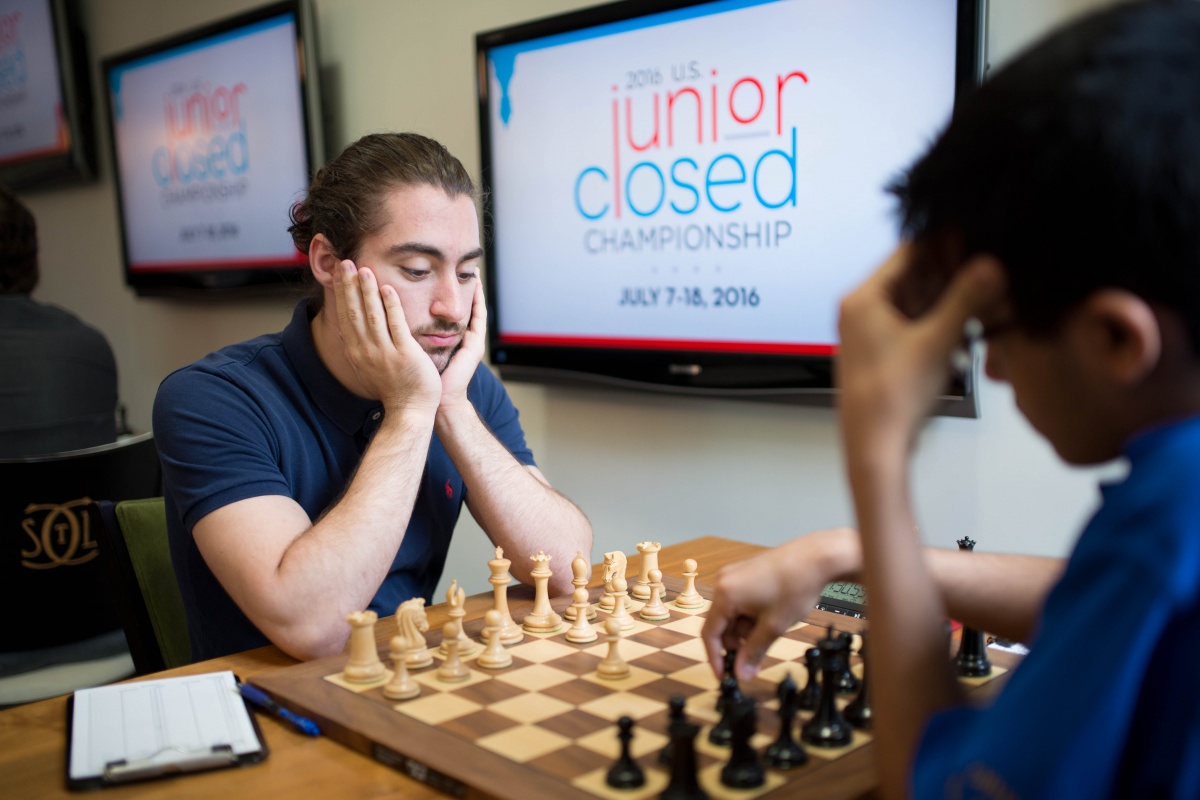 The players went into the Tarrasch variation of the French defense, with black taking back on d5 with the queen. White got a slight edge out of the opening, owing primarily to the pair of bishops. However, Aleksandr Ostrovskiy was not able to put the game away, during time trouble and the pieces were traded down until Chandra and Ostrovskiy were in a bishops-of-opposite color endgame. The commentators criticized Ostrovskiy for letting the defending champion of the hook, but after three consecutive losses it is understandable that the Russian-born New Yorker did not seek any more risk.
The players went into the Tarrasch variation of the French defense, with black taking back on d5 with the queen. White got a slight edge out of the opening, owing primarily to the pair of bishops. However, Aleksandr Ostrovskiy was not able to put the game away, during time trouble and the pieces were traded down until Chandra and Ostrovskiy were in a bishops-of-opposite color endgame. The commentators criticized Ostrovskiy for letting the defending champion of the hook, but after three consecutive losses it is understandable that the Russian-born New Yorker did not seek any more risk.
Checa vs. Troff : 1/2-1/2
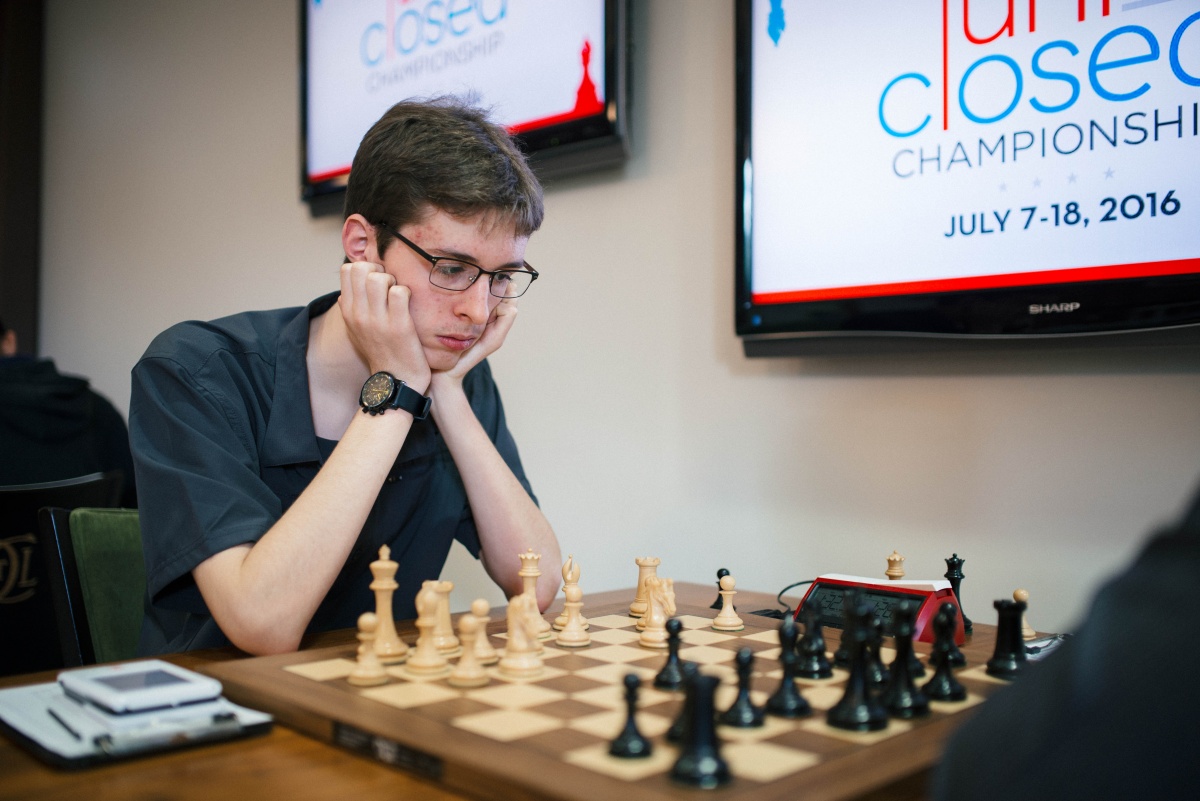 Nicolas Checa decided to go for the English opening which Troff faced with the main variation, turning into a position reminiscent of the Sicilian Dragon. Troff got good piece activity on the queenside whilst Checa lashed out with his pawns on the Kingside side of the board and his central pawn majority. However, after minor pieces were exchanged, Checa’s king proved to be a little too open, allowing Troff to escape with a perpetual check after the loss of a pawn in the early middle game.
Nicolas Checa decided to go for the English opening which Troff faced with the main variation, turning into a position reminiscent of the Sicilian Dragon. Troff got good piece activity on the queenside whilst Checa lashed out with his pawns on the Kingside side of the board and his central pawn majority. However, after minor pieces were exchanged, Checa’s king proved to be a little too open, allowing Troff to escape with a perpetual check after the loss of a pawn in the early middle game.
Brown vs. Xiong: 1/2-1/2
Facing the top seed and tournament leader with white was a tough challenge for FM Michael Brown. The game turned into a theory-heavy Grunfeld Indian defence, in which Brown got a slight advantage out of the opening. Xiong seemed to take over the initiative when he timed the typical f5 central break well, but Brown reacted well and found counter play when his rook reached the 7th rank. When the Queens came off the board, the players found themselves in a drawish endgame in which the Texas Grandmaster saw no more chance to further increase his lead.
Harmon-Velloti vs. Bodek : 1/2-1/2
Fans were excited to see Michael Bodek’s trademark Sicilian Dragon appear in the opening. Luke Harmon-Vellotti went for the calm 9.0-0-0 variation and got an edge by surprising his opponent with the rare Queen to e1. White seemed to build up a stable advantage, but Bodek managed to balance the scale with a speculative exchange sacrifice. For a moment, it seemed like the unfortunate International Master was on his way to obtain an advantage, but Harmon-Vellotti was able to bail out by offering an exchange of queens and scoring a perpetual. A more detailed take on the game can be found here:
Li vs. Liang: 1/2-1/2
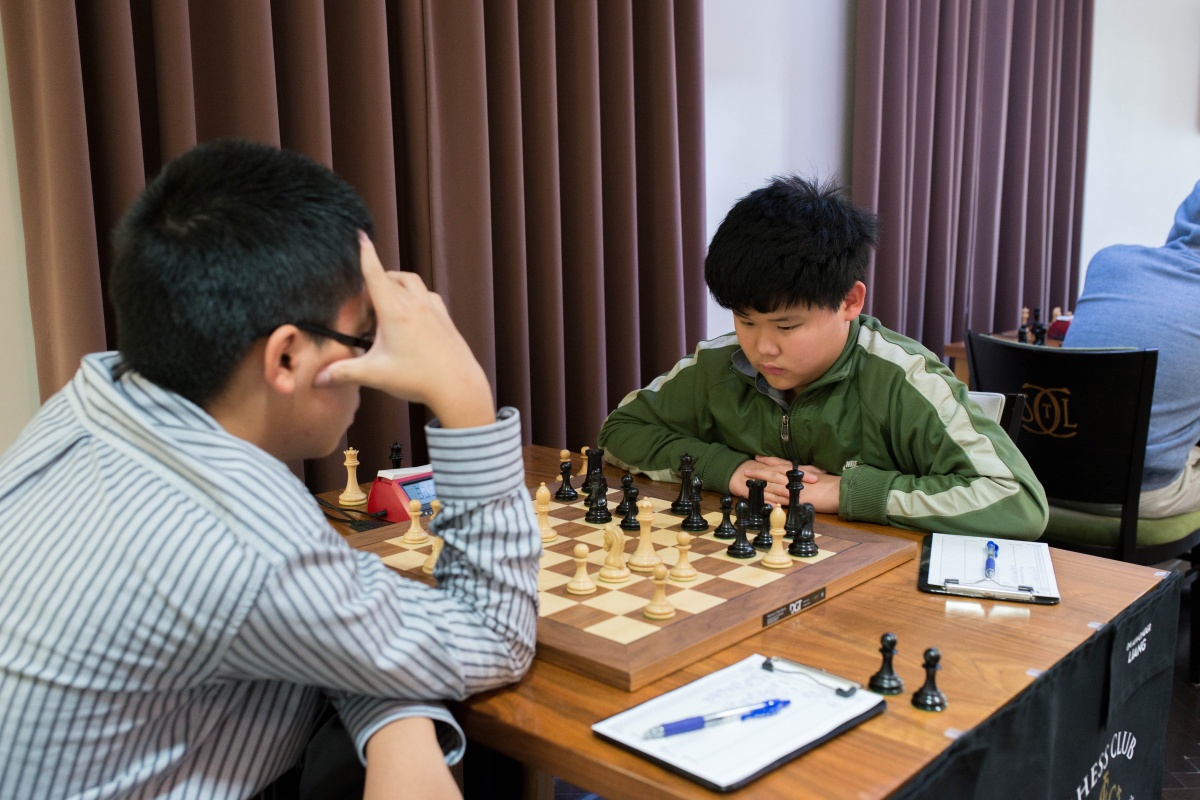 Ruifeng Li enthusiastically sacrificed a pawn against Awonder Liang, hoping to propel himself to a second place in the standings. Li had piece activity and a kingside pawn storm going for him, but the youngster, Awonder Liang, held to a stubborn defense. Li got back his pawn and then immediately sacrificed it again to open the h-file, allowing his rooks the access to the Black King. The Texas IM seemed to be on his way to score an important win, but failed to convert an exchange up in the endgame, allowing the thirteen year old Wisconsinite to retain the sole second place.
Ruifeng Li enthusiastically sacrificed a pawn against Awonder Liang, hoping to propel himself to a second place in the standings. Li had piece activity and a kingside pawn storm going for him, but the youngster, Awonder Liang, held to a stubborn defense. Li got back his pawn and then immediately sacrificed it again to open the h-file, allowing his rooks the access to the Black King. The Texas IM seemed to be on his way to score an important win, but failed to convert an exchange up in the endgame, allowing the thirteen year old Wisconsinite to retain the sole second place.
By GM Robin van Kampen
The 7th round showed the players were fatigued but still looking to give it their all. After 4 hours of play, not a single had been decided yet which set a new record in this year’s tournament.
Bodek vs. Brown: 0-1
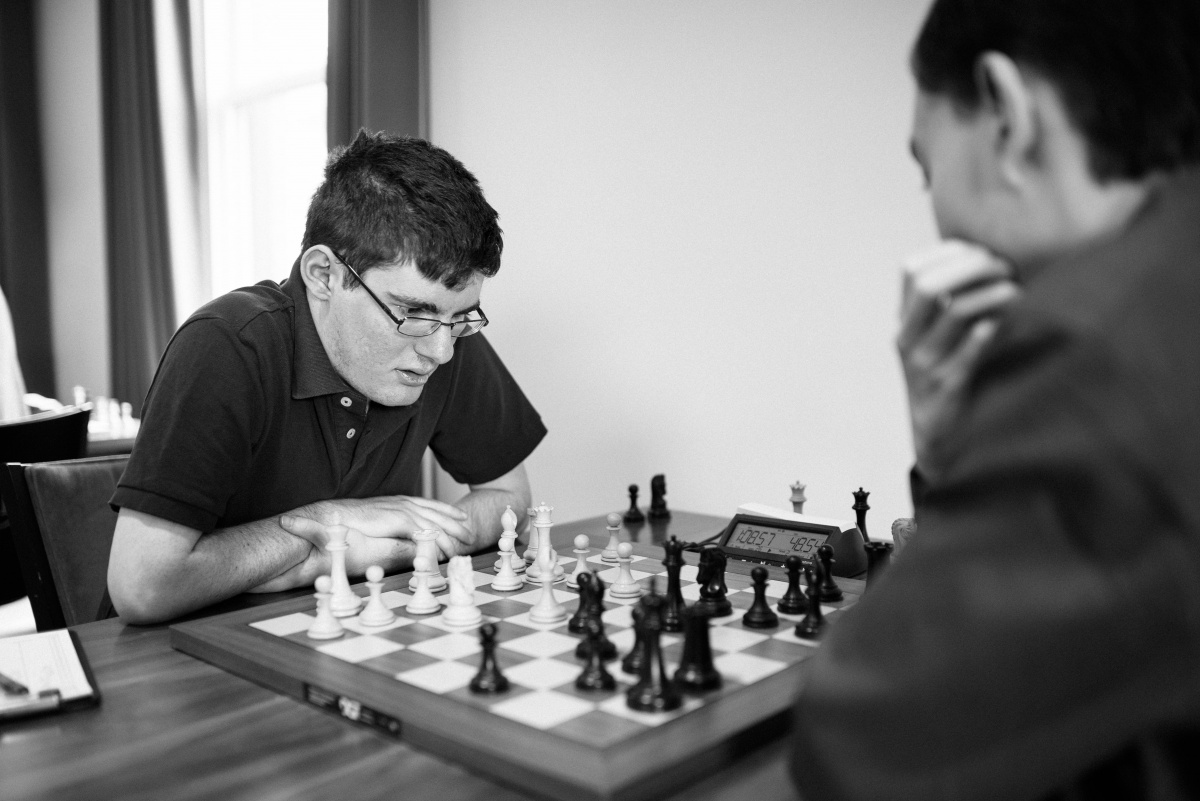 Michael Bodek played the English in order to sidestep Michael Brown’s Nimzo-Indian. The International Master from New Rochelle, NY is a veteran in this year’s tournament, having participated twice before, but has yet to find his form scoring only 2 draws from 7 games. Bodek got an advantage out of the opening, but Michael Brown won a pawn when he threatened to trap White’s rook. Bodek responded well and got the initiative again once the center opened up. When the players reached an ending with only heavy pieces left, Michael brown slowly but surely saw the defenses around his King being breached. What happened next was truly heartbreaking; after showing amazing technique in the endgame, the luckless Michael Bodek blundered a simple mate in time trouble. As Michael Brown pointed out after the game, the 1 out of 7 points are misrepresenting the quality of chess Bodek has displayed thus far, and one can only hope that the last two rounds can offer some reconciliation.
Michael Bodek played the English in order to sidestep Michael Brown’s Nimzo-Indian. The International Master from New Rochelle, NY is a veteran in this year’s tournament, having participated twice before, but has yet to find his form scoring only 2 draws from 7 games. Bodek got an advantage out of the opening, but Michael Brown won a pawn when he threatened to trap White’s rook. Bodek responded well and got the initiative again once the center opened up. When the players reached an ending with only heavy pieces left, Michael brown slowly but surely saw the defenses around his King being breached. What happened next was truly heartbreaking; after showing amazing technique in the endgame, the luckless Michael Bodek blundered a simple mate in time trouble. As Michael Brown pointed out after the game, the 1 out of 7 points are misrepresenting the quality of chess Bodek has displayed thus far, and one can only hope that the last two rounds can offer some reconciliation.
Li vs. Ostrovskiy: 1-0
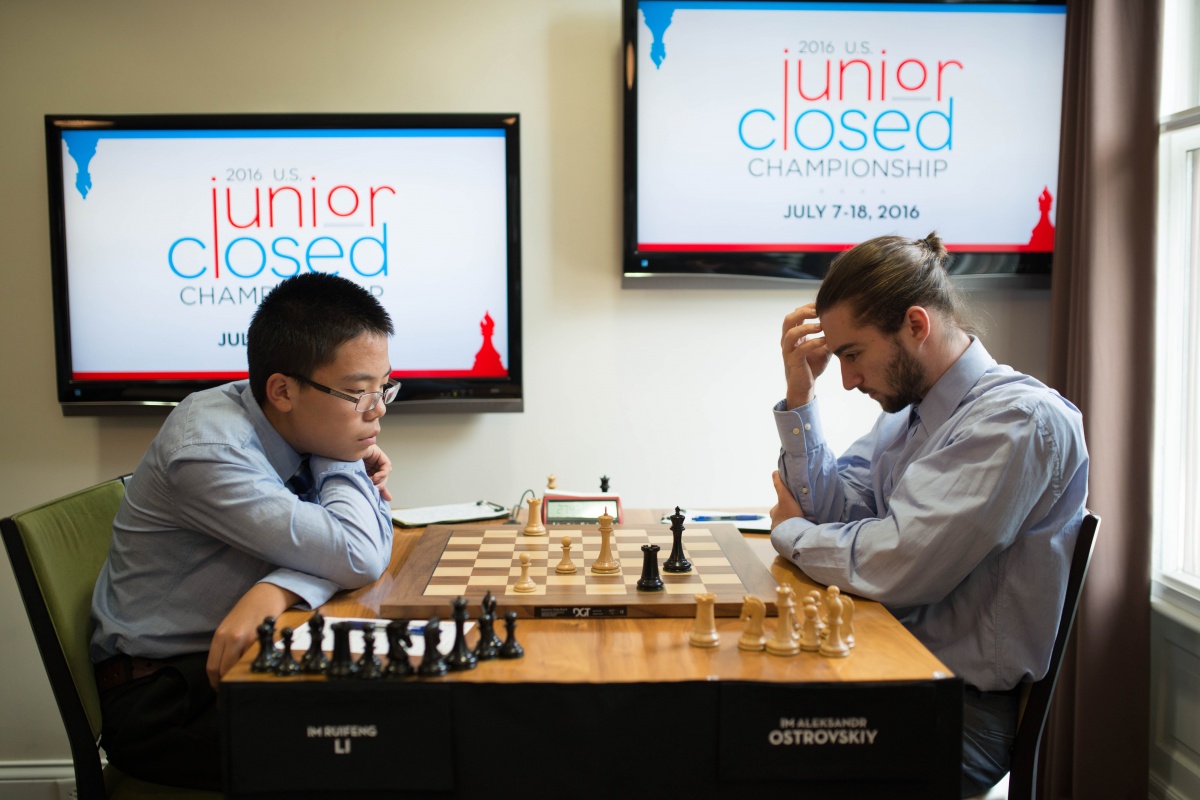 Ruifeng Li showed no mercy to Alexander Ostrovskiy, who after beating Jeffery Xiong, lost his last two games. Li opened up with the rare b3 and played the opening creatively. A slight edge turned into an extra pawn and Ostrovskiy was destined for a long defense. The Russian-born New Yorker played tenaciously, but erred once he made it to a theoretically drawn rook endgame. After a dull start of the tournament, Ruifeng Li is back at a solid +1 score, which means he will be in the race for second place. Ostrovskiy’s ambitious play has backfired in the last three rounds, putting him in 7th place with two rounds left to go.
Ruifeng Li showed no mercy to Alexander Ostrovskiy, who after beating Jeffery Xiong, lost his last two games. Li opened up with the rare b3 and played the opening creatively. A slight edge turned into an extra pawn and Ostrovskiy was destined for a long defense. The Russian-born New Yorker played tenaciously, but erred once he made it to a theoretically drawn rook endgame. After a dull start of the tournament, Ruifeng Li is back at a solid +1 score, which means he will be in the race for second place. Ostrovskiy’s ambitious play has backfired in the last three rounds, putting him in 7th place with two rounds left to go.
Liang vs. Harmon-Vellotti: 1/2-1/2
Awonder Liang got a slight advantage out of a calm English opening. In the early middle game, Luke Harmon-Vellotti showed good understanding of the position when he allowed himself a few backwards moves to improve the positioning of his Knight. The Wisconsinite who is currently in second place retained his advantage the entire game, but never got enough out of his positional edge to get the Idahoan IM in real trouble. In the endgame White won a pawn, but Black’s blockade proved to be enough to secure the draw.
Xiong vs. Checa: 1-0
Jeffery Xiong got an early opening advantage against Nicolas Checa’s Chebanenko Slav. Nonetheless, Checa’s strategy worked out well. Even though Jeffery had the Bishop pair and a space advantage, the Texas GM struggled to find a constructive plan. The players maneuvered for over 20 moves, until Jeffery opted for a central breakthrough which lead to a slightly better endgame for White. Checa counted on the opposite-colored bishops to increase his drawing chances, but erred in the late endgame after being forced to sacrifice the Bishop. As a result, Jeffery was able to increase his lead to a full point ahead of Awonder Liang.
A more detailed take on the game here:
Troff vs. Chandra: 0-1
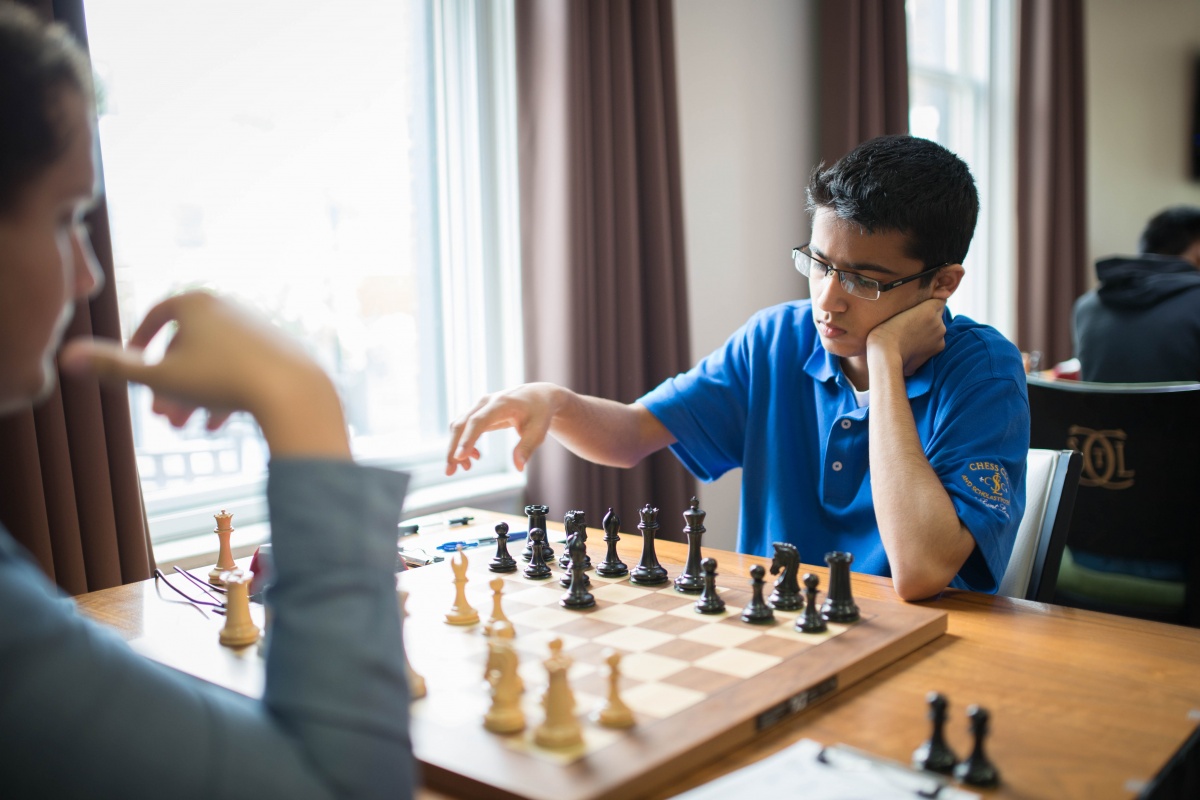 Defending Champion Akshat Chandra quickly equalized out of the opening after Kayden Troff failed to utilize his lead in development. When Chandra managed to block Troff’s isolated pawn, the GM-elect got a slight but stable edge. Troff tried to exchange his isolated d-pawn, lost material in the tactical skirmish that ensued, but played provocatively by marching his King down the board. After a complicated time-trouble phase, the off-form Grandmaster had a chance to equalize, but lost an exchange in the complications, costing him the game. A good comeback for the defending champion, who is still in the race for 2nd place.
Defending Champion Akshat Chandra quickly equalized out of the opening after Kayden Troff failed to utilize his lead in development. When Chandra managed to block Troff’s isolated pawn, the GM-elect got a slight but stable edge. Troff tried to exchange his isolated d-pawn, lost material in the tactical skirmish that ensued, but played provocatively by marching his King down the board. After a complicated time-trouble phase, the off-form Grandmaster had a chance to equalize, but lost an exchange in the complications, costing him the game. A good comeback for the defending champion, who is still in the race for 2nd place.
By GM Robin van Kampen
After 5 hard fought rounds, the participants had the Wednesday off to prepare themselves for the second half of the tournament. Whereas most players stayed in and rested up, Kayden Troff had a busy schedule. On Wednesday morning the Grandmaster from Utah was awarded the prestigious eagle scout award with festivities celebrating both his newly earned title, as well as his GM title which he achieved at the early age of 16.
Ostrovskiy vs. Troff: 0-1
The newly crowned Eagle Scout has had a rough tournament and finished with a disappointing score of 1,5/5 in the first half of the tournament. A day away from the chessboard bore its fruit as the GM found his form winning a complicated game against New-York based International Master Alexandr Ostrovskiy. Ostrovskiy was the first one to divert from his previous games against Xiong and Bodek, and got a pleasant position out of the opening. Troff decided to sacrifice a pawn, hoping to seize the initiative but soon found him on the defense when Ostrovskiy sacrificed a piece in return! A few moves later the International Master should have reconciled himself with a draw, but bravely decided to play on with only 5 minutes left for over 10 moves. Ostrovskiy got the chance he was looking for after Troff erred, but missed the golden opportunity to support his connected central passed pawns. When the players reached move 40, Troff was able to isolate the White Knight and not much later Ostrovskiy resigned as he found himself down a full rook. Not a perfect game by the 2014 U.S. Junior Champion , but the Grandmaster paved the way for a strong recovery in the second half.
Chandra vs. Xiong: 0-1
 Akshat Chandra opted for a topical line in the g3 Grunfeld against Jeffery Xiong. The defending champion had a pleasant advantage out of the opening as he controlled several important dark squares, but Xiong played tenaciously. Chandra gave up his light-squared Bishop in return for a strong-looking initiative, but once the GM-elect ran out of easy moves it turned out Xiong still had everything under control. Looking for an energetic way to continue, Chandra burned up a lot of time and slowly but surely Xiong’s position improved. In time trouble the top-seed retained his opponents play in an impressive matter, which granted him a large advantage once the time control was reached. Xiong never let go of the advantage, and showed sophisticated technique, granting him the full point and the leading position in the tournament. The 15 year old Texas GM has shown great willpower by rebounding with 2 wins after his unexpected loss to Alexandr Ostrovskiy in round 4.
Akshat Chandra opted for a topical line in the g3 Grunfeld against Jeffery Xiong. The defending champion had a pleasant advantage out of the opening as he controlled several important dark squares, but Xiong played tenaciously. Chandra gave up his light-squared Bishop in return for a strong-looking initiative, but once the GM-elect ran out of easy moves it turned out Xiong still had everything under control. Looking for an energetic way to continue, Chandra burned up a lot of time and slowly but surely Xiong’s position improved. In time trouble the top-seed retained his opponents play in an impressive matter, which granted him a large advantage once the time control was reached. Xiong never let go of the advantage, and showed sophisticated technique, granting him the full point and the leading position in the tournament. The 15 year old Texas GM has shown great willpower by rebounding with 2 wins after his unexpected loss to Alexandr Ostrovskiy in round 4.
Checa vs. Bodek: 1-0
Michael Bodek did not find the appropriate way to develop his pieces against Nicolas Checa’s delayed Catalan set-up. As a result the 14-year-old International Master obtained a large advantage, but the White edge was lost when opting for the wrong attempt to change the Queens. What happened next was odd; instead of developing his previously restricted pieces, Bodek went right for Checa’s King but the attack turned out to be harmless. When Checa reached an ending where he could dominate Bodek’s rook with his two knights, the win was trivial.
Brown vs. Liang: 1/2-1/2
 Michael Brown opted for an offbeat opening against Awonder Liang’s Grunfeld-Indian defense. The New Yorker got a slight edge, but Liang equalized by bravely thrusting his a-pawn in order to block Whites dark-squared Bishop. When the center opened up in the middle game, the youngest participant in the tournament sacrificed a pawn which discoordinated Brown’s pieces. As more pieces came off, Brown was forced to return the pawn, but the equilibrium was never truly broken. Awonder Liang seemed to be in trouble for a moment, but correctly judged a rook endgame with a pawn down to be a dead draw.
Michael Brown opted for an offbeat opening against Awonder Liang’s Grunfeld-Indian defense. The New Yorker got a slight edge, but Liang equalized by bravely thrusting his a-pawn in order to block Whites dark-squared Bishop. When the center opened up in the middle game, the youngest participant in the tournament sacrificed a pawn which discoordinated Brown’s pieces. As more pieces came off, Brown was forced to return the pawn, but the equilibrium was never truly broken. Awonder Liang seemed to be in trouble for a moment, but correctly judged a rook endgame with a pawn down to be a dead draw.
Harmon-Vellotti vs. Li 1-0
Ruifeng Li started out in his trademark style when he sacrificed a pawn as early as move 13 to make way for his pieces on the Queenside. Harmon-Vellotti reacted well and got the edge when Li opened up his own King’s position to get out of a pin. In the middle game the position remained approximately balanced, but when Harmon-Vellotti managed to exchange the Queens Black was left with several weaknesses in an ending. Harmon-Vellotti skillfully prevented Li’s counter play and slowly but surely picked up the Black pawns. Li resigned when the Idaho IM launched an attack against his King, whilst already being two pawns down. Luke Harmon-Vellotti still has good chances for a top 3 position, with a neat 3.5/6 score.
By Grandmaster Alejandro Ramirez
Achieving the grandmaster title is a huge feat. The hours spent every day studying, the days spent in airplanes, buses and airports just to travel to tournaments, the weeks spent at tournament halls, the months trying to perfect every strategy, truly are countless. There is a reason many people dedicate their entire lifetime to this sport without ever being able to reach the coveted title. Out of the millions of chess players worldwide, there are less than 1,500 grandmasters, and in America there are less than one hundred. The requirement list to achieve this title is strict: a rating of at least 2500 and earning three grandmaster norms, which means an amazingly high 2600 performance in at least three international tournaments sanctioned so by the International Chess Federation (FIDE).
 Becoming an Eagle Scout is another incredible achievement. It is calculated that only four percent of Boy Scouts are ever granted their maximum rank, and the requirements necessary for this take many years to fulfill. One of the main founders of the Chess Merit Badge, Dr. Jeanne Sinquefield, explained “To make Eagle, you need 21 merit badges of which ten can be a variety of areas. Making chess a merit badge means that is one of the merit badges you can earn on the road to Eagle Scout. “
Becoming an Eagle Scout is another incredible achievement. It is calculated that only four percent of Boy Scouts are ever granted their maximum rank, and the requirements necessary for this take many years to fulfill. One of the main founders of the Chess Merit Badge, Dr. Jeanne Sinquefield, explained “To make Eagle, you need 21 merit badges of which ten can be a variety of areas. Making chess a merit badge means that is one of the merit badges you can earn on the road to Eagle Scout. “
To be both is truly one of a kind. Yesterday, one of the participants of the 2016 U.S. Junior Closed Championship, an incredibly strong tournament itself with the top ten under 20 players in the entire country, became the first chess grandmaster to reach the rank of Eagle Scout. Kayden Troff, from Utah, was honored with a small, intimate ceremony at the Chess Plaza at Forest Park. Troff said during the ceremony “I started chess and scouts both at a very young age so I can definitely say both have meant a lot in my life.”
 The correlation between Scout service and chess is an easy one to make. Through the Chess Club and Scholastic Center of Saint Louis, spearheaded by Dr. Jeanne and Rex Sinquefield, chess has already helped thousands of kids in the Saint Louis metroplex improve their skills in pattern recognition, memorization, calculation, planning, strategy and many others. Numerous studies have proven that chess is a great tool for education.
The correlation between Scout service and chess is an easy one to make. Through the Chess Club and Scholastic Center of Saint Louis, spearheaded by Dr. Jeanne and Rex Sinquefield, chess has already helped thousands of kids in the Saint Louis metroplex improve their skills in pattern recognition, memorization, calculation, planning, strategy and many others. Numerous studies have proven that chess is a great tool for education.
Kayden's Eagle Scout Service Project was running a chess camp for children with disabilities in Utah. Participants ranged from kindergarten to high school with a majority being in elementary school. When asked to talk yesterday in Forest Park, it was clear that Kayden is a humble and smart young man—qualities that are exemplary for both a chess player and an Eagle Scout.

The Chess Merit Badge has quickly become one of the most popular badges in the Boy Scouts of America merit badge catalogue. “Since the Boy Scouts of America started the Chess Merit Badge,” Dr. Jeanne Sinquefield stated, “we have had over 100,000 boy scouts in America earn their Chess Merit Badge.” Out of the 130+ badges available, the Chess Merit Badge is undoubtedly one of fastest-growing badges available. It, of course, was not missing from Kayden's sash.
Kayden is one of the two grandmasters at the U.S. Junior Closed Championship, and despite a rocky start, he is still in a fighting position in the tournament. The tournament is currently being led by Jeffery Xiong from Texas and Awonder Liang from Wisconsin. Make sure to follow the action live online at uschesschamps.com.
